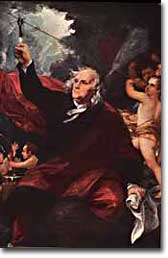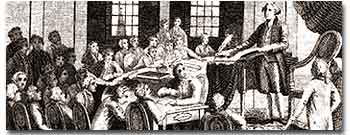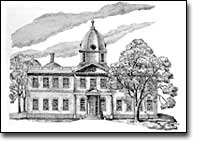15b. A Cast of National Superstars

Benjamin Franklin was the premier scientist, author, businessman and all-around scholar of his time.
At the same time that Shays' Rebellion attempted to force the government to take a new course of action in response to hard times, another group of Americans gathered to consider a very different vision for the future of the republic. The group was especially concerned about economic policy and the way that competing state policies often worked at cross-purposes. Responding to such concerns, the Virginia legislature called for a convention to meet in Annapolis, Maryland, in 1786 to discuss commercial matters. Only twelve delegates came from five states, but they agreed to meet again the next year in Philadelphia.
When Shays' Rebellion erupted in the interim, this group had even stronger reasons to meet to discuss plans for responding to the range of problems in the "critical period" of the 1780s. Following on the possibility of widespread popular unrest as evidenced by Shays' Rebellion, the Congress, in January 1787, directed the meeting to consider revisions to the Articles of Confederation.

The Constitutional Convention in Philadelphia brought together all the great leaders of the United States (unless they came from Rhode Island).
The Philadelphia Convention drew fifty-five delegates from twelve states (Rhode Island refused to send anyone to a meeting about strengthening the power of the central government). Most of the delegates had gained national-level experience during the Revolution by serving as leaders in the military, the Congress, or as diplomats. The impressive group included many prominent Revolutionary leaders like Benjamin Franklin, George Washington, and Robert Morris. Some of the older leaders of the Revolution, however, were not present. Thomas Jefferson and John Adams were abroad serving as diplomats to France and England, respectively.
Meanwhile, key local leaders like Sam Adams of Boston had lost his bid to be a delegate, while the Virginian patriot Patrick Henry was elected, but refused to go because he opposed the purpose of the Convention. In their place were a number of younger leaders, who had been less prominent in the Revolution itself. Most notable among them were the Virginian James Madison and the West Indian-born New Yorker, Alexander Hamilton.

Charles Willson Peale drew these sketches of the Maryland State House, site of the Annapolis Convention of 1786.
These national "superstars" did not, however, include people from western parts of the country, nor did it include any artisans or tenant farmers. Indeed, there was only a single person of modest wealth whom we could consider a yeoman farmer. These were superstars and that meant that they did not reflect anything close to the full range of American society. Partly because the delegates had already served as national representatives, they shared a general commitment to a strong central government. Many were strong nationalists who thought the Articles of Confederation gave too much power to the states and were especially concerned about state governments' vulnerability to powerful local interests. Instead, the delegates to the Philadelphia Convention aimed to create an energetic national government that could deal effectively with the major problems of the period from external matters of diplomacy and trade to internal issues of sound money and repayment of public debt.






